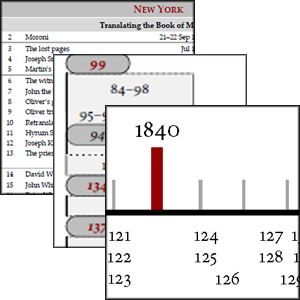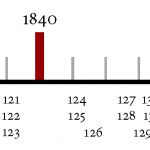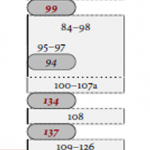
Since the Doctrine and Covenants has no storyline, it helps to have other resources to give us the larger picture.
Here are some handouts I’ve created for use in giving an overview of the Doctrine and Covenants. They are combined into one PDF file (I originally had three handouts, but I’ve since added a fourth to the collection). The handouts are:
- Section Titles and Divisions
- Timeline of Revelations
- Chronological Reading Diagram
- Chronological Reading Checklist
Among other things, each handout explains how the sections of the D&C can be arranged chronologically, but each handout visually portrays this in a different way. I recommend printing front-and-back, so that you can hand out the entire collection on just three sheets of paper.
You can download the color version if you’re just printing out one copy for yourself (they really don’t have much in the way of color; they’re mostly black text with some rubrics). Or you can download the black-and-white versions, which I’ve tried to shade just right for photocopying.
Each handout includes an explanation on it. When I have some time, I hope to do an individual post for each handout, explaining in greater detail how I created it, what information it provides, why I made certain choices, and ideas for how to use it in teaching situations. For the time being, though, I just wanted to get them up here on the web so people can use them for the coming year’s adult Sunday school curriculum. Following is a brief description of each handout.
1. Section Titles and Divisions

This is a table of information similar to the Chronological Order of Contents in your print edition of the Doctrine and Covenants (note: my dates differ because I’ve used more recent research from the Joseph Smith Papers project). It has each section in numerical order, with the date and place it was received, as well as a suggested title I came up with. In addition, I broke the sections into five major geographical groups (2–40 New York; 41–112 Ohio; 113–123 Missouri; 124–135 Illinois; 136–OD-2 The West). Then within those major groups, I inserted headings that broke them down into minor groups of sections based on common themes, such as translating the Book of Mormon, or time spent in Liberty Jail (these subdivisions and their labels, by the way, correspond to the major and minor headings in the Structured Edition).
Hopefully this kind of dividing and subdividing helps readers keep track of broader patterns and events as they read, making it easier to remember the context—a particularly difficult task in this book of scripture, since it lacks a storyline. For an example of one pattern, see Figure 8: Separation as Migration, on page 39 of my monograph on spiritual death.
2. Timeline of Revelations

This is a timeline with all the sections placed on it according to date of reception. You’ll notice that a few sections fall on the timeline out of numerical order. The section numbers that are more than a year removed are bolded (and colored red, in the color version).
This timeline illustrates a few interesting patterns, such as the fact that over half the Doctrine and Covenants was received in just a three-year span, as well as the fact that fewer textual/literary revelations were received as time went on (some day I’ll get around to recounting a great insight from Richard Holzapfel about why that would be the case).
3. Chronological Reading Diagram

This is a diagram that I conceived of as a way of quickly guiding a reader who wants to know how to read the Doctrine and Covenants in chronological order. Doing so requires jumping around in the book, and it’s easy to get lost without a diagram like this. In addition, it explains how to read it in conjunction with the two other books of scripture from the modern era: Joseph Smith—History and the Articles of Faith. (By the way, with some careful printing and cutting, this handout can be made into a two-sided half-sheet.)
I think reading the scriptures in chronological order is a valuable exercise that everyone needs to try at least once. If we want to be serious students of the scriptures, it’s crucial to understand the sequence things were revealed in. I’m hoping this chart makes that easier to do for those who are keen on that endeavor.
4. Chronological Reading Checklist

This checklist conveys the same information as the Diagram (#3 above), but in a table format similar to the Divisions of Sections chart (#1 above). Many people will find this checklist easier to understand and use than the less-familiar diagram.
I removed the Place of Reception column and with the extra space I was able to include labels for the third-tier divisions (the thin grey lines). I also added a column showing the number of verses in each passage; this might help you pace your reading if you want to divide the book into readings of roughly uniform length.
For a more detailed explanation, see the post dedicated to the Chronological Reading Checklist.
Conclusion
Each of these charts (or some version of them) can be found in the table of contents and/or appendixes of my custom version of the scriptures: the Structured Edition of the Doctrine and Covenants. You can download the book for free; I’d recommend using it for your Sunday school reading this year.
I taught Gospel Doctrine today and used these handouts to identify principles and applications for our lives. As Latter-day Saints, we are accustomed to studying individual verses and drawing out insights from short phrases and individual words. However, many valuable ideas can also be gained by stepping back and looking at larger patterns. I hope these handouts help you do so. I’d love to hear from you in the comments section about how you’ve used these handouts, how you shared them, and what insights you gained from doing so.
This is definitely a really good idea and love the concept you have came up with here. I did try to access the B&W PDF, but it took me to a page that said “No results found.” May want to check that out if you have not been made aware of it. I will definitely print this up and place it in with my D&C. Thank you for this information.
I fixed the link for the black-and-white version. Thanks for the heads up.
Wow, these are great. I have sent them to our Gospel Doctrine teachers and they are excited to get them.
Thank you for these! Exactly what I was looking for and more!
I noticed the date of this posting is very recent. I am wondering if you used any of the resources from the Joseph Smith Papers project and if you will need to update any info in your charts with the updates this week on the new 2013 edition of the scriptures. Do you anticipate having to make any changes? I have not taken the time to correlate your material with the latest resources.
Thank you for your time and effort to improve gospel scholarship and spiritual growth! We need more members to be a proactive spiritual presence on the web. THANKS!
Thanks for the kind words, Russell. The answer is no, I’ve not incorporated the new 2013 edition’s data because I created this about a month before it came out. But I am now working feverishly to update these handouts to be consistent with that new information, in the available nooks and crannies of my schedule.
It won’t be a completely straightforward update, though, because the new 2013 edition made a few choices that differ from the available research. For example, for section 20, both Harper and Woodford give 10 Apr 1830, but the 2013 edition gives “soon after 6 Apr 1830.” So I’m going to have to decide whether to simply stick with one source (the 2013 edition) to simplify things for my readers, or whether to deviate in small ways if it allows for more specificity. It’s going to take a little time to discover those discrepancies, weigh them, choose my approach, then recreate the handouts.
Regarding due dates, all I can say is that it’s at the top of my project list right now!
Thank you!
Oh my! You have no idea. I am so grateful for these. You’re the bomb, Nathan.
Glad they’re helping, Ginger! If I’d known last time I saw you that you would like these so much, I could have given you several more handouts and diagrams from my computer. I haven’t posted them on this site yet, but I’ll get around to it soon.
I love your structural chapter reading charts, but I can’t find one for the Doctrine and Covenants or for the Pearl of Great Price.
Say no more! I just posted the structural chapter reading chart for the Doctrine and Covenants.
The Pearl of Great Price doesn’t really work as a stand-alone reading chart, for two reasons. (1) If you want to read it in chronological order by itself, you would pretty much just read it as-is (with the sole exception, perhaps, of putting Moses 1 and the end of Abraham). (2) If you want to read it in chronological order in conjunction with the other standard works, you’ll find check boxes on the other reading charts for the New Testament (Joseph Smith—Matthew, after Matthew 24) and the Doctrine and Covenants (Articles of Faith, after section 126).
I have not yet placed check boxes on the Old Testament chart for Moses or Abraham, mostly because they parallel multiple Genesis chapters, rather than fitting into one spot in Genesis (that is, they repeat the scriptural text, with modifications, kind of like Joseph Smith—Matthew except it’s across several chapters in a row). If you want to see how Moses and Abraham relate to the Genesis text, go download and read The Pearl of Great Price: Structured Edition and pay attention to the parallel bars to the right of the text, in Moses 2–8′ and Abraham 3–5′.
I have not placed check boxes on the Doctrine and Covenants chart for Joseph Smith—History because the latter (JS-H) is only one chapter, but it is interspersed among several D&C sections. Reflecting that with a check box chart would look awkward and messy, so I didn’t even try to integrate JS-H. But you can accomplish the same task with the chronological reading checklist for the Doctrine and Covenants.
Thank you so very much!